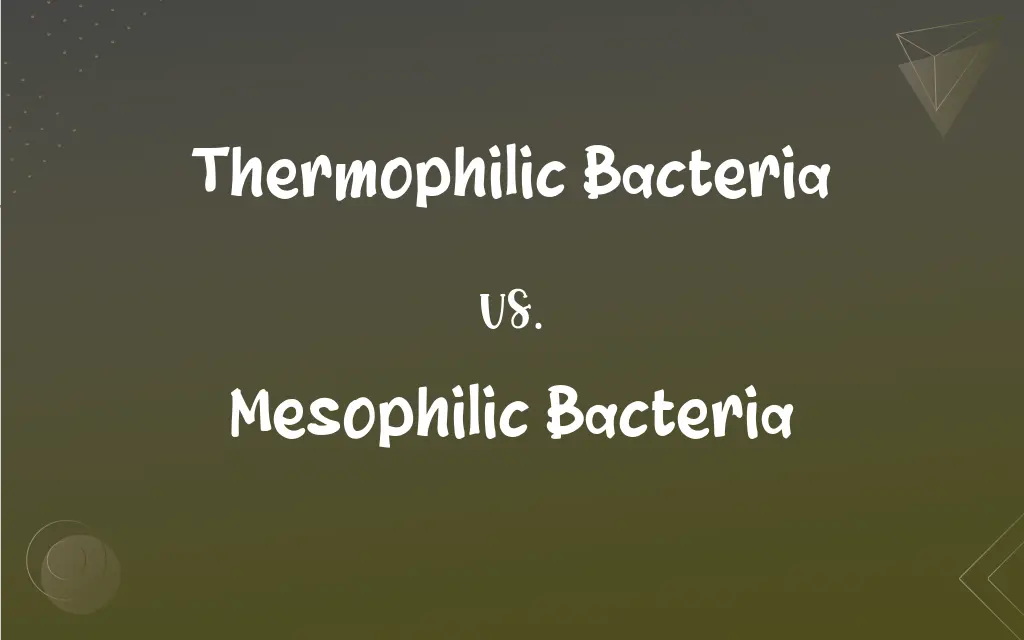Thermophilic Bacteria vs. Mesophilic Bacteria: What's the Difference?
Edited by Janet White || By Harlon Moss || Updated on October 28, 2023
Thermophilic bacteria thrive at high temperatures (50°C-80°C); mesophilic bacteria prefer moderate temperatures (20°C-45°C).

Key Differences
Thermophilic bacteria are microorganisms that have adapted to survive in extremely hot environments, typically between 50°C and 80°C. In contrast, mesophilic bacteria are those that grow best in moderate temperature ranges, usually between 20°C and 45°C. Thermophiles can be found in places like hot springs and hydrothermal vents, showcasing their ability to withstand scalding conditions. Mesophiles, however, are more commonly found in environments such as soil, water, and the human body, indicative of their preference for milder conditions.
Both thermophilic bacteria and mesophilic bacteria play significant roles in various industries and natural processes. Thermophiles, for instance, are crucial in biotechnological applications due to their heat-stable enzymes. These bacteria can aid in processes that require high temperatures without the enzymes denaturing. Mesophilic bacteria, on the other hand, are pivotal in food fermentation, waste decomposition, and even in our digestive system, highlighting their importance in day-to-day life and industrial activities.
One of the fascinating things about thermophilic bacteria is their unique cellular structures and enzymes that allow them to function at elevated temperatures. Their proteins have a higher proportion of ionic bonds, making them more stable. Conversely, mesophilic bacteria have cellular machinery optimized for moderate temperatures, and exposure to high temperatures can denature their proteins and halt their metabolic processes.
To understand the significance of these bacteria in the broader context, consider the application of composting. Thermophilic bacteria are essential during the high-temperature phase, breaking down tough organic materials rapidly. In contrast, mesophilic bacteria dominate the initial and final stages of composting, working on easily degradable materials and maturing the compost, respectively.
Comparison Chart
Optimal Temperature Range
Typically between 50°C and 80°C
Typically between 20°C and 45°C
ADVERTISEMENT
Common Environments
Hot springs, hydrothermal vents, geothermal soils
Soil, water, human body, ambient environments
Industrial Applications
Biotechnology for heat-stable enzymes
Food fermentation, waste decomposition
Protein Stability
High ionic bond proportion for heat stability
Suited for moderate temperatures
Role in Composting
Active during high-temperature phase
Dominate initial and final stages
Thermophilic Bacteria and Mesophilic Bacteria Definitions
Thermophilic Bacteria
Thermophilic bacteria contain heat-stable enzymes.
Biotechnological processes often utilize thermophilic bacteria for their robust enzymes.
ADVERTISEMENT
Mesophilic Bacteria
Mesophilic bacteria can be sensitive to extreme temperatures.
Exposing mesophilic bacteria to boiling water often kills them.
Thermophilic Bacteria
Thermophilic bacteria can withstand temperatures that denature typical proteins.
Where most bacteria perish, thermophilic bacteria flourish in intense heat.
Mesophilic Bacteria
Mesophilic bacteria dominate in the human digestive system.
Our gut houses a variety of mesophilic bacteria aiding digestion.
Thermophilic Bacteria
Thermophilic bacteria possess specialized protein structures for heat resistance.
The unique protein configurations in thermophilic bacteria enable their survival in hot springs.
Mesophilic Bacteria
Mesophilic bacteria play a role in waste decomposition.
Landfills and compost bins witness active decomposition thanks to mesophilic bacteria.
Thermophilic Bacteria
Thermophilic bacteria are adapted to extremely hot environments.
Thermophilic bacteria thrive in the boiling waters of geysers.
Mesophilic Bacteria
Mesophilic bacteria grow best in moderate temperatures.
Mesophilic bacteria are abundant in everyday environments like garden soil.
Thermophilic Bacteria
Thermophilic bacteria contribute to high-temperature composting phases.
In compost heaps, thermophilic bacteria break down tough organic materials during the heat peaks.
Mesophilic Bacteria
Mesophilic bacteria are essential for many fermentation processes.
Yogurt production relies on the activity of mesophilic bacteria.
FAQs
Where can you typically find mesophilic bacteria?
Mesophilic bacteria are commonly found in moderate environments like soil, water, and the human body.
Do mesophilic bacteria have any role in food production?
Yes, mesophilic bacteria are vital for many fermentation processes, such as making yogurt or cheese.
Can thermophilic bacteria survive in space?
While space conditions are harsh, some experiments suggest certain thermophiles might survive, especially if shielded from extreme radiation.
Can thermophilic bacteria be used in food production?
Yes, certain thermophilic bacteria are used in specific fermentation processes, like producing certain cheeses.
Why are thermophilic bacteria important in biotechnology?
Thermophilic bacteria produce heat-stable enzymes that are valuable in processes requiring high temperatures.
Are there organisms other than bacteria that are thermophilic?
Yes, besides bacteria, there are thermophilic fungi, archaea, and even some algae.
How can one differentiate between thermophilic and mesophilic bacteria in a lab?
Growth temperature tests can determine their optimal range, distinguishing thermophiles from mesophiles.
Can mesophilic bacteria be found in hot springs?
While hot springs are dominated by thermophiles, some regions, especially cooler peripheries, might house mesophiles.
Are there any known dangers of thermophilic bacteria to humans?
While many thermophiles are harmless, a few can produce toxins or cause infections, especially in immunocompromised individuals.
Can thermophilic bacteria survive in cold environments?
While thermophilic bacteria are adapted for high temperatures, they are less efficient or dormant in cold conditions.
What happens if mesophilic bacteria are exposed to very high temperatures?
High temperatures can denature the proteins of mesophilic bacteria, leading to their death.
Are all bacteria either thermophilic or mesophilic?
No, besides these two, there are also psychrophilic bacteria that thrive in cold environments.
Why are thermophilic bacteria crucial for composting?
Thermophilic bacteria accelerate the breakdown of tough organic materials during the high-temperature phase of composting.
Are mesophilic bacteria always harmless to humans?
While many mesophiles are beneficial or neutral, some can be pathogenic and cause diseases.
Do mesophilic bacteria have any industrial applications?
Yes, besides food fermentation, they play roles in waste treatment, biofuel production, and more.
What are thermophilic bacteria?
Thermophilic bacteria are microorganisms that thrive in extremely hot environments, usually between 50°C and 80°C.
How have thermophilic bacteria evolved to withstand heat?
Thermophilic bacteria have unique protein structures, higher ionic bonds, and specialized cellular machinery for heat resistance.
Are mesophilic bacteria found in animals other than humans?
Yes, mesophilic bacteria inhabit the digestive systems of many animals, aiding in digestion.
What would happen if mesophilic bacteria were introduced to a hot spring?
Most mesophilic bacteria would perish due to the extreme heat, but a few might adapt or survive in cooler regions of the spring.
Is it true that mesophilic bacteria are essential for human health?
Yes, many mesophilic bacteria in our gut play roles in digestion and maintaining gut health.
About Author
Written by
Harlon MossHarlon is a seasoned quality moderator and accomplished content writer for Difference Wiki. An alumnus of the prestigious University of California, he earned his degree in Computer Science. Leveraging his academic background, Harlon brings a meticulous and informed perspective to his work, ensuring content accuracy and excellence.
Edited by
Janet WhiteJanet White has been an esteemed writer and blogger for Difference Wiki. Holding a Master's degree in Science and Medical Journalism from the prestigious Boston University, she has consistently demonstrated her expertise and passion for her field. When she's not immersed in her work, Janet relishes her time exercising, delving into a good book, and cherishing moments with friends and family.































































